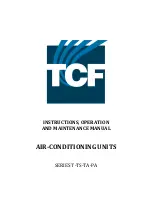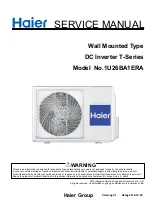
6 Electrical installation
Installation manual
16
23EA
Daikin Altherma 3 R F
4P629088-1C – 2021.11
a
Safety device (pressure and temperature relief valve of
domestic hot water tank; pressure relief valve of domestic
hot water tank kit)
b
Tundish
c
Fixed grating
d
Trapped gully
D1
Metal discharge pipe from safety device to tundish
D2
Discharge pipe from tundish, with continuous fall. See
Building Regulation G3 section 3.56, Table 03 and
worked example.
10
After completing the installation, the installer has to fill out the
warning label on the tank with indelible ink. The warning label
can be found on the unit top plate.
WARNING
The discharge pipes from the pressure relief valves MUST
terminate in a safe and visible position without forming any
risk to persons in the vicinity.
WARNING
▪ Discharge piping, tundish, drain valves, etc. MUST be
positioned away from any electrical components.
▪ The discharge pipe away from the tundish MUST
terminate in a safe, visible position without forming any
risk to persons in the vicinity.
WARNING
▪ Do NOT install any valves between the domestic hot
water tank and relief valves/expansion vessel.
▪ Do NOT install shut-off valves between the expansion
relief valve and the domestic hot water tank.
NOTICE
▪ All pipework and fittings must be flushed free of flux
and debris prior to installing the domestic hot water
tank kit. Failure to do this may cause irreparable
damage to the tank kit controls. Flush the system by
opening the hot water tap.
▪ The tundish pipework must be a 22 mm metal pipe with
a minimal vertical length of 300 mm below the tundish
before any elbows or bends in the pipework. All
pipework must have a continuous fall of 1 in 200
thereafter. Maximum permitted (equivalent) length of
22 mm pipework is 9 m. Each bend or elbow is
equivalent to 0.8 m of pipework.
5.4.3
To connect the recirculation piping
Prerequisite:
Only required if you need recirculation in your system.
1
Remove the top panel from the unit, see
10].
2
Cut out the rubber grommet on top of the unit, and remove the
stop. The recirculation connector is placed below the hole.
3
Route the recirculation piping through the grommet and connect
it to the recirculation connector.
4
Reattach the top panel.
5.4.4
To fill the water circuit
To fill the water circuit, use a field supply filling kit. Make sure you
comply with the applicable legislation.
INFORMATION
Make sure both air purge valves (one on the magnetic filter
and one on the backup heater) are open.
5.4.5
To fill the domestic hot water tank
1
Open every hot water tap in turn to purge air from the system
pipe work.
2
Open the cold water supply valve.
3
Close all water taps after all air is purged.
4
Check for water leaks.
5
Manually operate the field-installed pressure relief valve to
ensure a free water flow through the discharge pipe.
5.4.6
To insulate the water piping
The piping in the complete water circuit MUST be insulated to
prevent condensation during cooling operation and reduction of the
heating and cooling capacity.
If the temperature is higher than 30°C and the humidity is higher
than RH 80%, the thickness of the insulation materials should be at
least 20 mm to prevent condensation on the surface of the
insulation.
6
Electrical installation
INFORMATION
This unit is a heating only model. Therefore, all references
to cooling in this document are NOT applicable.
DANGER: RISK OF ELECTROCUTION
WARNING
ALWAYS use multicore cable for power supply cables.
WARNING
Make sure that the electrical wiring does NOT touch the
refrigerant gas pipe, which can be very hot.
a
a
Refrigerant gas pipe















































